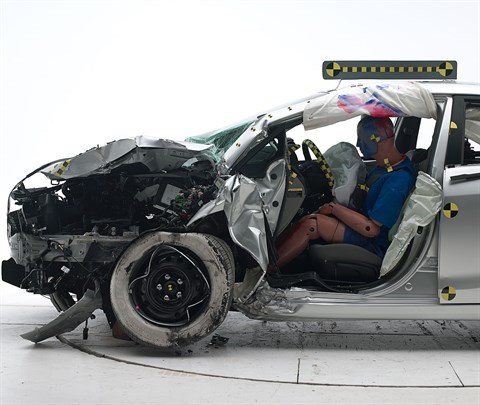Small overlap front: driver-side
Rating applies to 2015-16 models
Tested vehicle: 2015 Kia Forte LX 4-door
The Kia Forte was redesigned for the 2014 model year. Beginning with the 2015 models, Kia increased the strength of the occupant compartment structure (A-pillar, door sill, seat support crossmember, among other parts) to improve occupant protection in small overlap frontal crashes.
| Evaluation criteria | Rating |
|---|---|
| Structure and safety cage | |
| Driver injury measures | |
| Head/neck | |
| Chest | |
| Hip/thigh | |
| Lower leg/foot | |
|
Driver restraints and dummy kinematics
The dummy’s head contacted the frontal airbag but slid off the left side. Additionally, the seat belt allowed excessive forward excursion of the dummy’s head and torso, contributing to the head hitting the instrument panel. The side curtain airbag deployed but does not have sufficient forward coverage to protect the head from contact with forward side structure and outside objects. The side torso airbag deployed. | |

Action shot taken during the small overlap frontal crash test.

The dummy's position in relation to the door frame, steering wheel, and instrument panel after the crash test indicates that the driver's survival space was not maintained well.

During the crash, the dummy's head and torso contacted the airbag before moving to the left. The seat belt allowed the dummy to move too far forward, and the head hit the instrument panel.

Despite considerable intrusion of the door hinge pillar, door sill, and instrument panel, risk of injuries to the dummy's legs and feet was low.
Moderate overlap front: original test
Rating applies to 2014-18 models
Tested vehicle: 2014 Kia Forte EX 4-door
The Kia Forte was redesigned for the 2014 model year. Moderate overlap frontal ratings are assigned by the Institute based on a test conducted by Hyundai/Kia.
| Evaluation criteria | Rating |
|---|---|
| Overall evaluation | |
| Structure and safety cage | |
| Driver injury measures | |
| Head/neck | |
| Chest | |
| Leg/foot, left | |
| Leg/foot, right | |
| Driver restraints and dummy kinematics | |
Side: original test
Rating applies to 2015-18 models
Tested vehicle: 2015 Kia Forte LX 4-door with standard front and rear head curtain airbags and standard front seat-mounted torso airbags
The Kia Forte was redesigned for the 2014 model year. Beginning with 2015 models, the seat-mounted side torso airbags and front door trim were modified to improve occupant protection in side impact crashes. Side ratings are assigned by the Institute based on a test conducted by Hyundai/Kia.
Because the side structure and the rear occupant compartment of the car were not changed, the injury ratings for the passenger and the structure rating are based on tests of both the 2014 and 2015 models.
| Evaluation criteria | Rating |
|---|---|
| Overall evaluation | |
| Structure and safety cage | |
| Driver injury measures | |
| Head/neck | |
| Torso | |
| Pelvis/leg | |
| Driver head protection | |
| Rear passenger injury measures | |
| Head/neck | |
| Torso | |
| Pelvis/leg | |
| Rear passenger head protection | |
Roof strength
Rating applies to 2014-18 models
Tested vehicle: 2014 Kia Forte LX 4-door
| Overall evaluation | |
|---|---|
| Curb weight | 2,812 lbs |
| Peak force | 14,015 lbs |
| Strength-to-weight ratio | 4.98 |
Head restraints & seats
Seat type: Manual cloth seats built after May 2013
| Overall evaluation | |
|---|---|
| Dynamic rating | |
| Seat/head restraint geometry |
About the head restraint & seat test
Currently, IIHS tests apply only to front seats.
Child seat anchors
Rating applies to 2015-18 models
| Evaluation criteria | Rating |
|---|---|
| Overall evaluation | |
| Vehicle trim | LX |
| Seat type | cloth |
This vehicle has 2 rear seating positions with complete child seat attachment (LATCH) hardware.
It has 1 additional seating position with a tether anchor only.
| Evaluation criteria | Rating |
|---|---|
| Overall evaluation | |
| Vehicle trim | LX |
| Seat type | cloth |
| Rating icon | Rating |
|---|---|
| G | Good |
| A | Acceptable |
| M | Marginal |
| P | Poor |
| Seating positions that rely on borrowed lower anchors or have only a tether anchor available are not rated. | |
thether anchor symbol | Tether anchor |
lower anchor symbol | Lower anchors |
| Lower anchor(s) can be borrowed from adjacent positions(s) | |
| No hardware available |
Details by seating position
| Position | Rating |
|---|---|
| 1 | |
| Tether anchor | |
| easy-to-find location | |
| no other hardware could be confused for anchor | |
| Lower anchors | |
| too deep in seat | |
| not too much force needed to attach | |
| easy to maneuver around anchors | |
| 2 | |
| Tether anchor | |
| easy-to-find location | |
| no other hardware could be confused for anchor | |
| Lower anchors | |
| none available | |
| 3 | |
| Tether anchor | |
| easy-to-find location | |
| no other hardware could be confused for anchor | |
| Lower anchors | |
| too deep in seat | |
| not too much force needed to attach | |
| easy to maneuver around anchors |
